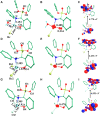Theoretical exploration on structures, bonding aspects and molecular docking of α-aminophosphonate ligated copper complexes against SARS-CoV-2 proteases
- PMID: 36263127
- PMCID: PMC9575937
- DOI: 10.3389/fphar.2022.982484
Theoretical exploration on structures, bonding aspects and molecular docking of α-aminophosphonate ligated copper complexes against SARS-CoV-2 proteases
Abstract
Recent years have witnessed a growing interest in the biological activity of metal complexes of α-aminophosphonates. Here for the first time, a detailed DFT study on five α-aminophosphonate ligated mononuclear/dinuclear CuII complexes is reported using the dispersion corrected density functional (B3LYP-D2) method. The electronic structures spin densities, FMO analysis, energetic description of spin states, and theoretical reactivity behaviour using molecular electrostatic potential (MEP) maps of all five species are reported. All possible spin states of the dinuclear species were computed and their ground state S values were determined along with the computation of their magnetic coupling constants. NBO analysis was also performed to provide details on stabilization energies. A molecular docking study was performed for the five complexes against two SARS-CoV-2 coronavirus protein targets (PDB ID: 6LU7 and 7T9K). The docking results indicated that the mononuclear species had a higher binding affinity for the targets compared to the dinuclear species. Among the species investigated, species I showed the highest binding affinity with the SARS-CoV-2 Omicron protease. NPA charge analysis showed that the heteroatoms of model species III had a more nucleophilic nature. A comparative study was performed to observe any variations and/or correlations in properties among all species.
Keywords: DFT; MEP map; NBO; copper species; molecular docking.
Copyright © 2022 Yadav, Kumar, Mittal, Yadav, Seidel and Ansari.
Conflict of interest statement
The authors declare that the research was conducted in the absence of any commercial or financial relationships that could be construed as a potential conflict of interest.
Figures







Similar articles
-
DFT and TDDFT exploration on electronic transitions and bonding aspect of DPA and PTDC ligated transition metal complexes.J Mol Model. 2024 Apr 4;30(5):122. doi: 10.1007/s00894-024-05912-5. J Mol Model. 2024. PMID: 38570356
-
DFT and TDDFT exploration on the role of pyridyl ligands with copper toward bonding aspects and light harvesting.J Mol Model. 2023 Nov 3;29(11):358. doi: 10.1007/s00894-023-05765-4. J Mol Model. 2023. PMID: 37919553
-
Structures, bonding aspects and spectroscopic parameters of morin, myricetin, and quercetin with copper/zinc complexes: DFT and TDDFT exploration.J Mol Model. 2025 Feb 5;31(3):75. doi: 10.1007/s00894-025-06296-w. J Mol Model. 2025. PMID: 39907807
-
Electronic structures, bonding aspects and spectroscopic parameters of homo/hetero valent bridged dinuclear transition metal complexes.Spectrochim Acta A Mol Biomol Spectrosc. 2022 Oct 5;278:121331. doi: 10.1016/j.saa.2022.121331. Epub 2022 May 5. Spectrochim Acta A Mol Biomol Spectrosc. 2022. PMID: 35597159
-
Synthesis, spectroscopic, and computational studies on molecular charge-transfer complex of 2-((2-hydroxybenzylidene) amino)-2-(hydroxymethyl) propane-1, 3-diol with chloranilic acid: Potential antiviral activity simulation of CT-complex against SARS-CoV-2.J Mol Struct. 2022 Mar 5;1251:132010. doi: 10.1016/j.molstruc.2021.132010. Epub 2021 Nov 28. J Mol Struct. 2022. PMID: 34866653 Free PMC article.
Cited by
-
DFT and TDDFT exploration on electronic transitions and bonding aspect of DPA and PTDC ligated transition metal complexes.J Mol Model. 2024 Apr 4;30(5):122. doi: 10.1007/s00894-024-05912-5. J Mol Model. 2024. PMID: 38570356
-
Safflower plant extract as a sustainable corrosion inhibitor for carbon steel in acidic media: a combined electrochemical and computational study.RSC Adv. 2025 Jun 23;15(26):21006-21025. doi: 10.1039/d5ra03333k. eCollection 2025 Jun 16. RSC Adv. 2025. PMID: 40551842 Free PMC article.
-
High-performance corrosion inhibitors for carbon steel in hydrochloric acid: electrochemical and DFT studies.RSC Adv. 2025 Aug 13;15(35):28666-28688. doi: 10.1039/d5ra04952k. eCollection 2025 Aug 11. RSC Adv. 2025. PMID: 40861989 Free PMC article.
-
DFT and TDDFT exploration on the role of pyridyl ligands with copper toward bonding aspects and light harvesting.J Mol Model. 2023 Nov 3;29(11):358. doi: 10.1007/s00894-023-05765-4. J Mol Model. 2023. PMID: 37919553
-
Photophysical properties of four-membered BN3 heterocyclic compounds: theoretical insights.J Mol Model. 2023 Oct 12;29(11):336. doi: 10.1007/s00894-023-05731-0. J Mol Model. 2023. PMID: 37828393
References
-
- Ali A., Sepay N., Afzal M., Sepay N., Alarifi A., Shahid M., et al. (2021). Molecular designing, crystal structure determination and in silico screening of copper(II) complexes bearing 8-hydroxyquinoline derivatives as anti-COVID-19. Bioorg. Chem. 110, 104772. 10.1016/j.bioorg.2021.104772 - DOI - PMC - PubMed
-
- Amira A., Aouf Z., K'tir H., Chemam Y., Ghodbane R., Zerrouki R., et al. (2021). Recent advances in the synthesis of α‐aminophosphonates: A review. ChemistrySelect 6, 6137–6149. 10.1002/slct.202101360 - DOI
LinkOut - more resources
Full Text Sources
Miscellaneous

